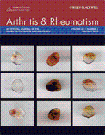Direct comparison of treatment responses, remission rates, and drug adherence in patients with rheumatoid arthritis treated with adalimumab, etanercept, or infliximab: Results from eight years of surveillance of clinical practice in the nationwide Danish DANBIO registry
Abstract
Objective
To compare tumor necrosis factor α inhibitors directly regarding the rates of treatment response, remission, and the drug survival rate in patients with rheumatoid arthritis (RA), and to identify clinical prognostic factors for response.
Methods
The nationwide DANBIO registry collects data on rheumatology patients receiving routine care. For the present study, we included patients from DANBIO who had RA (n = 2,326) in whom the first biologic treatment was initiated (29% received adalimumab, 22% received etanercept, and 49% received infliximab). Baseline predictors of treatment response were identified. The odds ratios (ORs) for clinical responses and remission and hazard ratios (HRs) for drug withdrawal were calculated, corrected for age, disease duration, the Disease Activity Score in 28 joints (DAS28), seropositivity, concomitant methotrexate and prednisolone, number of previous disease-modifying drugs, center, and functional status (Health Assessment Questionnaire score).
Results
Seventy percent improvement according to the American College of Rheumatology criteria (an ACR70 response) was achieved in 19% of patients after 6 months. Older age, concomitant prednisolone treatment, and low functional status at baseline were negative predictors. The ORs (95% confidence intervals [95% CIs]) for an ACR70 response were 2.05 (95% CI 1.52–2.76) for adalimumab versus infliximab, 1.78 (95% CI 1.28–2.50) for etanercept versus infliximab, and 1.15 (95% CI 0.82–1.60) for adalimumab versus etanercept. Similar predictors and ORs were observed for a good response according to the European League Against Rheumatism criteria, DAS28 remission, and Clinical Disease Activity Index remission. At 48 months, the HRs for drug withdrawal were 1.98 for infliximab versus etanercept (95% 1.63–2.40), 1.35 for infliximab versus adalimumab (95% CI 1.15–1.58), and 1.47 for adalimumab versus etanercept (95% CI 1.20–1.80).
Conclusion
Older age, low functional status, and concomitant prednisolone treatment were negative predictors of a clinical response and remission. Infliximab had the lowest rates of treatment response, disease remission, and drug adherence, adalimumab had the highest rates of treatment response and disease remission, and etanercept had the longest drug survival rates. These findings were consistent after correction for confounders and sensitivity analyses and across outcome measures and followup times.




